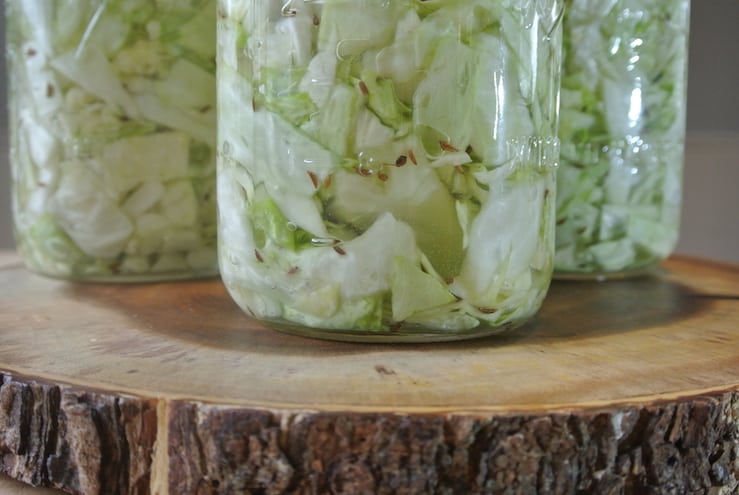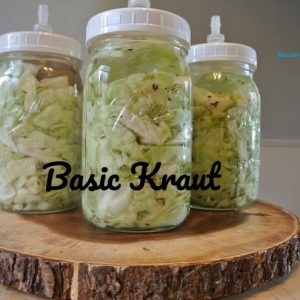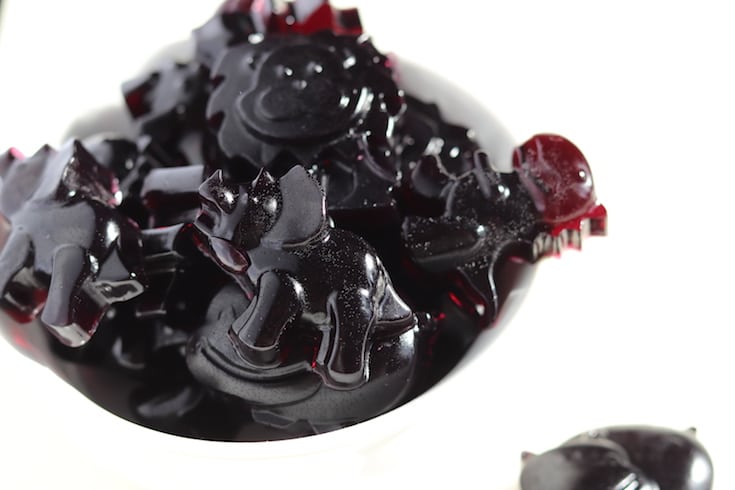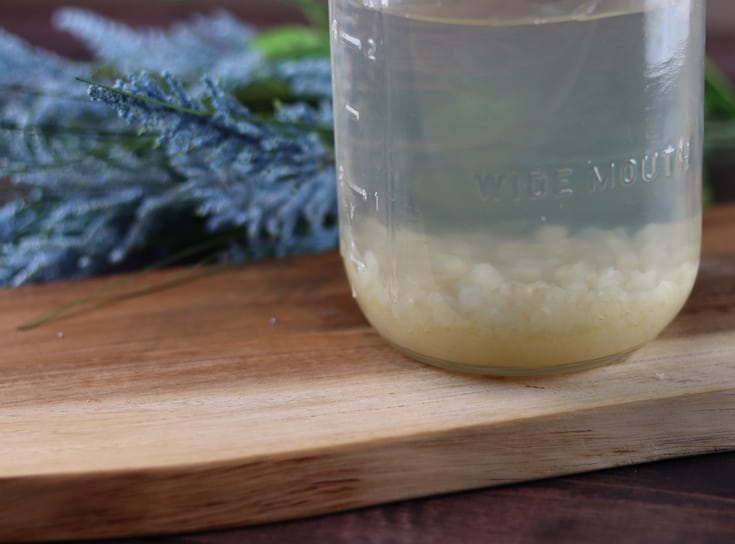You have probably heard that fermented foods like kraut (sauerkraut) are full of probiotics and that probiotics feed the good bacteria in your gut or microbiome. Now the question is how to get them into your daily routine so that they become a habit. You are much more likely to eat fermented foods if they are on hand all the time, of course. One easy way to assure that this is so is to make your own. Most fermented foods are truly simple to make and do not require a lot of time. I usually do it while I am in the kitchen making dinner anyway. See the bottom of the post for a basic recipe for Kraut that you can change up however you like.

- Breakfast: You’ve heard me say this before. Start your day with kefir (water or milk) mixed into a smoothie (or a “shake” as my kids call it). We have this in addition to our breakfast.
- Soups, Salads, and Sandwiches: Top your finished soup with veggie ferments (kraut and kimchi work well). Just be sure to let your soup cool for a minute or two so that you don’t kill the beneficial bacteria with the heat. You can also add veggie ferments to your salads. Radishes, beets, jicama, and carrots are my favorites). Add veggie ferments to your sandwiches. Pickles come to mind, of course
- Snack Time: Make fermented foods your snack We like to make homemade ranch dressing with homemade yogurt, and homeade kombucha mayo. The we dip raw veggies like carrot sticks and sugar snap peas for a healthy snack. Another favorite snack is homemade yogurt with a drizzle of maple syrup or a dollop of lemon curd.
- Bonus: Add a glass of kombucha or water kefir lemonade to your daily routine! So simple to do and so delicious.

Basic Kraut Recipe
- One large head cabbage (or 2 small)
- 2.5 Tablespoons Celtic Sea Salt
- Filtered Water
- Optional: Spices: one Tablespoon caraway or juniper berries (Caraway is my favorite.)
- Mason Jars (wide mouth quart), sterilized (3 or 4)
Airlocks, sterilized (optional but they do really protect your ferment) - Fermentation weights (or a sterilized flat rock)
Directions:
- First, take off the first couple of layers of cabbage. Then shred or cut the the cabbage. I like to do this with a knife because I like crunchy kraut, but you could use the shredder function on your food processor. Do not use the core.
- Put the shredded cabbage in a large glass or steel bowl.
- Next, sprinkle the salt over the cut cabbage. Let the salt sit on the cabbage for about 20 minutes or so.
- After the salt has soaked into the cabbage, use your hands to mix it and “work” it into the cabbage. You should be seeing the liquid in the bottom of the bowl grow. Work it for about 5 or 10 minutes. (You can do this with a wooden or stainless steel mallet as well.)
- Now mix in the spices if you are using them. I like to use 2 teaspoons to one tablespoon of caraway seeds.
- Finally, add the cabbage and salt (and spice) mixture to your mason jars. Pour the salty cabbage water over the top, dividing it equally between your jars. Add water to cover the cabbage, leaving about an inch or inch and a half from the top of the jar to allow for expansion during fermentation. Top with a fermentation weight to keep your cabbage submerged in brine. (Or you could use the cabbage core or a sterilized rock.) Keeping the cabbage submerged is crucial to not developing mold!
- Screw on your airlock lids or regular lids. The airlocks are optional, but they really do help protect your ferment.
- Let it set out of direct sunlight for at least 3 days and up to 2 weeks.
Basic Kraut Recipe
Ingredients
- One large head cabbage
- 3 Tablespoons Celtic Sea Salt
- Filtered Water
- Spices: Some common choices are caraway or juniper berries optional
- Mason Jars wide mouth quart, sterilized
- Airlocks sterilized (optional but they do really protect your ferment)
- Fermentation weights or a sterilized flat rock
Instructions
- First, Shred or cut the the cabbage. I like to do this with a knife, but you could use the shredder function on your food processor.
- Put the shredded cabbage in a large glass or steel bowl.
- Next, sprinkle the salt over the cut cabbage. Let the salt sit on the cabbage for about 20 minutes or so.
- After the salt has soaked into the cabbage, use your hands to mix it and "work" it into the cabbage. You should be seeing the liquid in the bottom of the bowl grow. Work it for about 5 or 10 minutes.
- Now add the spices if you are going to. I like to use 2 teaspoons to one tablspoon of caraway seeds.
- Finally, add the cabbage and salt mixture to your mason jars. Pour the salty cabbage water over the top, dividing it equally between your jars. Add water to cover the cabbage, leaving about an inch or inch and a half from the top of the jar to allow for expansion during fermentation.
- Let it sit out of direct sunlight for at least 3 days and up to 2 weeks.
Do you make your own kraut? What are your tricks for getting fermented foods into your daily diet?










